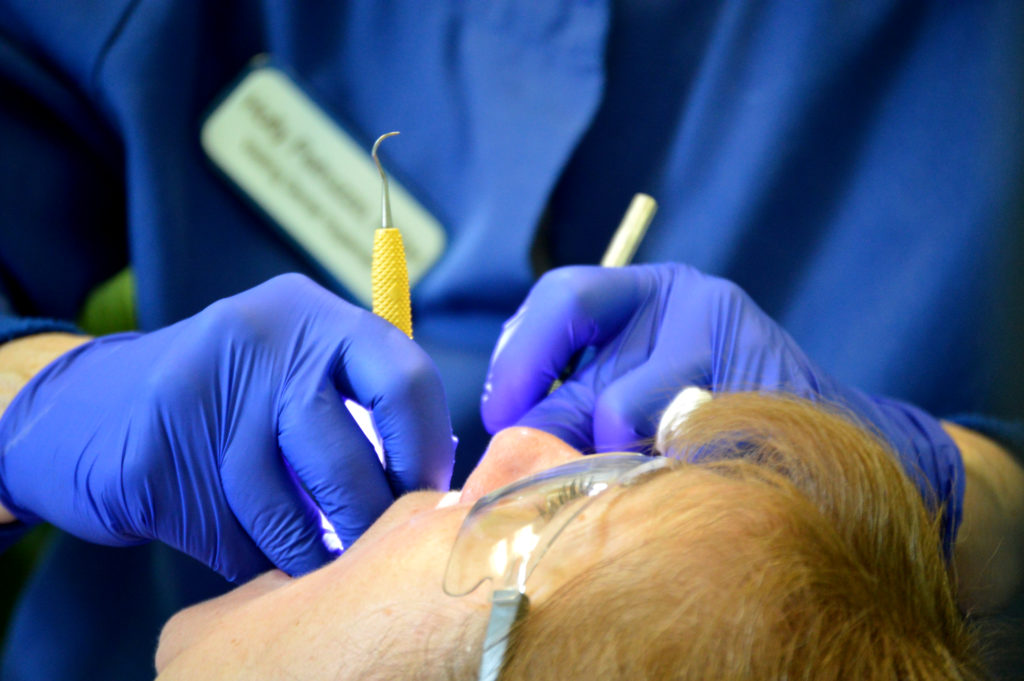
Holly Petruzzo, RDH, of Visiting Dental Hygienist, LLC inspects Elizabeth LaLiberte’s mouth for oral cancer during a visit at the Dartmouth Council on Aging. According to the American Cancer Society, around 50,000 new cases of oral cancer are reported every year. The average age for those diagnosed is 62.
This article originally appeared in the April 2019 edition of Senior Scope. Article and photos by Seth Thomas.
April is Oral Cancer Awareness Month, a reminder to inspect your mouth for anything irregular. Oral cancers can spread quickly, which is why early detection is important.
Oral cancer, which is the growth of abnormal cells, can form on the tissues lining the mouth, the roof of the mouth, the lips or the back of the throat. It occurs most commonly on the tongue, the floor of the mouth and the gums.
According to the American Cancer Society, around 50,000 new cases of oral cancer are reported every year. It affects more men than women, and the average age for those diagnosed is 62.
Dentists and dental hygienists will look for signs of oral cancer during checkups, but it’s important to know what to look for so you can discuss anything concerning with your dentist right away.
Oral cancer can appear as a sore or a lump anywhere in your mouth, lips, or throat, or as an area of red and white lesions. It may cause swelling in your jaw, it may make swallowing difficult or it may make your tongue feel numb.
Holly Petruzzo, a public health dental hygienist from Visiting Dental Hygienist, said that oftentimes these lumps or lesions are not painful, unlike a canker sore.
“Any lump or bump that stays there for two weeks has the potential to be something that needs to be addressed,” said Petruzzo. “Sometimes, after a biopsy, it turns out to be nothing. But it’s always better to err on the side of the caution than to ignore it.”
Since 2012, Petruzzo has been hosting dental cleanings and oral cancer screenings at local councils on aging. The program is funded by Coastline and the Executive Office of Elder Affairs.
She said that, while oral cancer can occur in both smokers and non-smokers, smoking will significantly increase your potential. In fact, most cases are linked to smoking and smokeless tobacco use. Other risk factors include heavy alcohol use, consuming alcohol and using tobacco products together, and poor nutrition.
During an oral cancer screening, Petruzzo will inspect the mouth for any abnormalities. She feels the sides of the neck and jaw for lumps, examines the sides of the tongue, and looks for bumps on the sides of the mouth.
“A lot of people that have dentures don’t realize that it’s a good idea to check underneath them,” said Petruzzo.
In addition to checking for oral cancer, good oral health includes frequent brushing and flossing. An increasing body of research has shown a connection between good oral hygiene and overall health.
Petruzzo’s Visiting Dental Hygeniest program helps local seniors keep smiling, with dental cleanings, denture cleanings, scaling and root cleanings, and fluoride treatments.

“They get a complete cleaning and then a fluoride treatment because, as we age, a lot of times recession happens and the root surface is not covered by enamel, and it’s far more susceptible to decay,” she said. “A lot of people, with all of the medications they’re on, suffer from dry mouth, which causes rapid decay.”
For dry mouth, Petruzzo recommends sugarless lozenges or sugarless gum, which can help stimulate saliva. Holding water in the mouth can also help with dry mouth.
Visits to a dental hygienist can help patients overcome the limitations of brushing. Brushing and flossing helps with the removal of plaque, which can cause decay and gum disease. When plaque hardens into tartar, it can no longer be removed by a toothbrush and requires a periodontal scaler.
“If someone’s really good about their home care, they’ll build up far less tartar. But once it starts to build up, you can’t get it off without scaling,” she said.
At-home oral cancer check: Knowledge is power, and knowing what’s happening inside your mouth before visiting a heath care professional will help you direct your conversation in the dentist’s chair. You can perform a self-exam at home. Here’s how.
- You’ll be inspecting your mouth for any: red or white patches, red and white patches, a sore that is not healing and easily bleeds, abnormal lumps or thickened tissue, or a lump on the neck or under the lower jaw.
- You will need a bright light and mirror
- Remove any dentures
- Look at and feel the inside of your lips and the front of your gums
- Inspect the roof of your mouth by tilting your head back
- Pull on your cheek to see the inside surface and back of the gums
- Stick your tongue out and look at it from every angle
- Feel for lumps on both sides of your neck and under your lower jaw
- Consult a health care professional immediately if you notice any of these signs
Resources
Call Holly Petruzzo, RDH, of Visiting Dental Hygienist, LLC at 774-766-7238 to schedule an appointment. Cleanings and referrals are for those age 60+ without dental insurance or with limited financial means.
Contact the Greater NB Community Health Center for info on their dental services at 508-992-6553.
Call the Massachusetts Smokers’ Helpline at: 1-800-QUIT NOW (1-800-784-8669) or visit KeepTryingMA.org.


Recent Comments